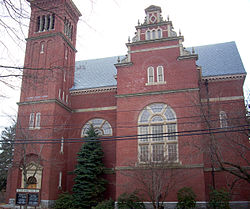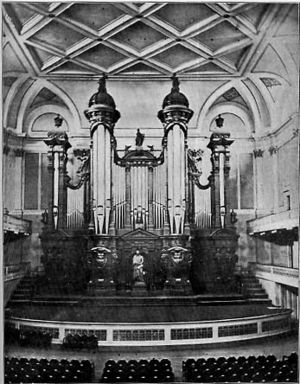- Methuen Memorial Music Hall
-
Methuen Memorial Music Hall
 Methuen Memorial Music Hall
Methuen Memorial Music HallLocation: 192 Broadway
Methuen, MassachusettsBuilt: 1909 Architect: Henry Vaughan NRHP Reference#: 78000462 Added to NRHP: December 14, 1978 Methuen Memorial Music Hall, initially named Serlo Organ Hall, was built by Edward Francis Searles to house "The Great Organ", a very large pipe organ that had been built for the Boston Music Hall. It was completed in 1909, and stands at 192 Broadway in Methuen, Massachusetts.
Contents
The Organ
"The Great Organ" was built by Walcker Orgelbau, arriving in the US from Europe in March 1863, with installation completed in November 1863. It was at the time believed to be the largest pipe organ in the United States, with 5,474 pipes and 84 registers.
The organ case was made by the Herter Brothers of New York from American Black Walnut, based on a case design by Hammatt Billings. The display pipes were manufactured from burnished English tin.
In 1881, the Boston Symphony Orchestra was founded and the Boston Music Hall was their first home. The orchestra required a lot of space for the performers, and the organ was removed to storage in 1884 and then sold for $5,000 to William O. Grover. Grover probably intended to donate the organ to the New England Conservatory of Music, but after his death in (circa 1897), it was auctioned to settle his estate. Searles purchased it at auction for $1,500 and began construction of a music hall in Methuen.
 Organ in its original installation at the Boston Music Hall[1]
Organ in its original installation at the Boston Music Hall[1]
Architecture
In 1899, Searles hired noted church architect Henry Vaughan, an architect he frequently hired for various projects, to design a concert hall for the organ to be located on property he owned adjoining the Spicket River. Probably no other building of this size has been built solely to house a pipe organ.
The exterior is brick in an Anglo-Dutch style, with an Italianate campanile and a gable with baroque volutes. The walls are over three feet thick with interior air gaps, making the building quite soundproof.
The hall is designed in a similar fashion to a church, having a cross shaped floorplan; a long central aisle ends at a stage in front of the pipe organ; including the organ, the hall is approximately one hundred feet long. Another aisle runs across the front of the stage area and out to the sides; this is seventy feet wide.
In the terminology of Christian church architecture, the nave is forty feet wide while the transepts extend to seventy feet, and the pipe organ is in the chancel.
There is a vaulted ceiling sixty-five feet high. Beneath the vault is an entablature whose cornice hides indirect lighting which illuminates and reflects off of the ceiling. There is also a catwalk. The total enclosed volume is over 300,000 cubic feet (8,500 m3), which gives a reverberation time of 4 seconds when the hall is empty.
The interior is designed in an English baroque style. It draws particularly from Christopher Wren's design for Church of Saint Stephan, Walbrook in London. The lower ten feet of wall surface are finished with dark oak paneling. The walls above that are plaster with brocade panels which in addition to their decorative appearance are placed to absorb excess reverberation. The floors are marble in an alternating color scheme of reddish-brown and gray.
History
After the hall's completion, it was used privately by Searles until his death in 1920. It then passed to Searles' secretary, Arthur Thomas Walker, as residuary legatee. Walker died in 1927, leaving the hall to his niece, Ina Cecil McEachran of Detroit.
In 1930, part of the property including the hall was purchased by Lillian Wightman Andrew (1982-1961), wife of local banker Francis Martin Andrew (1880–1967). In 1931, the hall was purchased by noted organbuilder Ernest M. Skinner
Under Skinner's ownership, there were public choral and organ performances which included works by Brahms, Bach, and Handel, with recitals by organists including Marcel Dupre and E. Power Biggs. In 1936, Skinner incorporated an organ building company on the property, "Ernest M. Skinner and Son Company" using the Methuen Organ Company factory building which stood near the music hall.
This business initially prospered, building several notable pipe organs including the one for the National Cathedral in Washington D.C. Interestingly, the National Cathedral was designed by Henry Vaughan, who designed the music hall. The Second World War caused the failure of the company, and in August 1942 the company assets, including the music hall, were transferred to trustees (Arthur T. Wasserman and Matthew Brown) as protection from creditors.
In 1943, a court decree allowed the Essex Savings Bank of Lawrence to sell the property in order to pay mortgages held by the Andrews and Skinner's son, Richmond H. Skinner. In June 1943, a fire destroyed the organ factory building but the music hall was largely undamaged. In July, the mortgage sale was completed, with Essex Savings Bank buying the property at auction for $55,000.
In May 1946, eight local residents founded a charitable organization to buy and maintain the music hall, operating it as a cultural center.
Current Usage
The Music Hall currently hosts numerous concerts and recitals and sometimes provides practice time for student organists. Most events occur in spring and summer, when there are up to three events a week. The hall is frequently rented for weddings and other private functions. As a wedding venue, it offers the unusual characteristic of looking like a traditional church while having no religious symbolism or affiliation.
See also
Notes
References
U.S. National Register of Historic Places Topics Lists by states Alabama • Alaska • Arizona • Arkansas • California • Colorado • Connecticut • Delaware • Florida • Georgia • Hawaii • Idaho • Illinois • Indiana • Iowa • Kansas • Kentucky • Louisiana • Maine • Maryland • Massachusetts • Michigan • Minnesota • Mississippi • Missouri • Montana • Nebraska • Nevada • New Hampshire • New Jersey • New Mexico • New York • North Carolina • North Dakota • Ohio • Oklahoma • Oregon • Pennsylvania • Rhode Island • South Carolina • South Dakota • Tennessee • Texas • Utah • Vermont • Virginia • Washington • West Virginia • Wisconsin • WyomingLists by territories Lists by associated states Other  Category:National Register of Historic Places •
Category:National Register of Historic Places •  Portal:National Register of Historic Places
Portal:National Register of Historic PlacesCoordinates: 42°43′29″N 71°11′07″W / 42.724856°N 71.185158°W
Categories:- Music venues in Massachusetts
- Buildings and structures in Methuen, Massachusetts
- Buildings and structures on the National Register of Historic Places in Massachusetts
- Pipe organs
Wikimedia Foundation. 2010.
